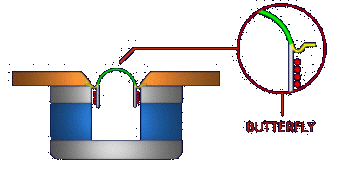

THE SPEAKER
The speaker is an electromechanical device that has the task to convert the electric signal coming from the amplifier in pressure waves that our auditory system perceives as sounds. For this function it is also called a transducer.
The most common speakers are classified as orthodynamic and isodynamic, according to the principle of operation. In orthodinamic speakers the force that sets the radiant diaphragm in motion is applied in one point only — perpendicular to the plane of the diaphragm itself. Only an accurate geometry allows every part of the diaphragm to move in phase. In isodynamic systems the force is equally distributed on the whole radiant surface. A few car-audio manufacturers only have produced isodynamic speakers, among them Bohlender-Graebener, Eminent Technology, ESS, Fostex, Infinity and Sony.
The orthodinamic speakers are evidently the most diffused and to them we'll refer from now on. They are substantially divided in two families, cone and dome, according to the shape of the radiant diaphragm. Generally speaking, it can be said that cone membranes are more suited for low and mid-low frequency reproduction (woofers and low-mids). Dome profiles are unbeatable in reproducing mid-high and high frequencies (mids and tweeters). There are obviously some variations on the theme, represented by cone-dome profiles of a lot of tweeters and some midranges (Morel) and by inverted-dome profiles of some tweeters of the recent past (Epicure).
In reference to the materials used in making diaphragms, they range from cellulose and polypropylene to carbon and kevlar for the cones. The domes are usually silk and polyamide along with aluminum and titanium and many other materials, often exotic.
Below you can observe the structure of a generic woofer: the frustum-of-cone diaphragm (green) results suspended inside the basket (orange) by two suspensions, one external called surround (pink) — generally foam, rubber or corrugated canvas — and one internal called spider (yellow) — almost always corrugated canvas. The only movement allowed by this configuration is that axial. Rigidly connected to the vertex of the cone there is the voice-coil, immersed in the middle of the pole piece of the magnet (light blue), in a narrow crack called air-gap (red).

As soon as current from the amplifier flows in the voice-coil it produces a magnetic field that interacts with that of the magnet. This forces the voice-coil to move, together with the cone with which it is integral. The shift and direction of this moving element are determined by the intensity and direction of the flow in the coil.
Conceptually the structure of a tweeter differs from that of a woofer in suspension, which is unique instead of dual. It is at the base of the dome, which is also the junction point with the voice-coil, and often — but not always — it is made of the same material of the dome to prevent glueing problems among different materials.

The whole dome/suspension/coil of a tweeter is called butterfly and this should tell you how much it is light, really more than even the smallest cone. The extremely close project and workmanship tolerances in tweeter manufacturing justify the fact that only a few builders in the world have developed the technological know-how to manufacture them.
So why are speakers morphologically so different according to the frequency they are asked to reproduce? The answer to this question brings us to analyze better multi-way systems
